Top 15 Weirdest Foods Around The World
 |
If a bacon sarnie just isn’t cutting it and you fancy something more exotic, how about sinking your teeth into some raw whale blubber? If that doesn’t quite float your boat, don’t worry, there’s always a crispy tarantula. If you’re hungry now, you won’t be by the end of this article. Here are 15 of the weirdest foods to try on your travels.
1. Shirako, Japan
 |
| Photo: On The Gas |
Shirako (sometimes spelled shiraku) is perhaps Japan’s weirdest dish. While this white paste may look like mayonnaise, it’s actually fish semen. Served on top of rice, fried in tempura batter, or even on top of custard, this dish is revered for its rich, velvety texture and mild sea-like taste.
Not only do people actually like shirako, it’s not the only name for fish sperm. In the US, we refer to it as fish milt instead, but it’s the same thing. Tuna milt is a normal thing to put on pasta in Sicily, while Romanians enjoy fried milt from freshwater fish, like carp. You can even find octopus and mollusk milt, although it’s a bit less common. In other words, people enjoy eating fish semen all over the world.
Milt is sometimes harvested by hand, but the easiest way to harvest it is to simply retrieve milt from the genitals of a dead fish. This also makes it easier to handle, since it’s packaged in a fish organ. Chefs occasionally pierce this membrane when they prepare milt dishes to work directly with the gel-like milt, but not always.
When it comes to odd foods, the real question is how good they taste. Shirako is definitely fairly approachable when it comes to physical enjoyment. In other words, if you didn’t know what you were eating was fish semen, you’d almost certainly enjoy it.
The taste and texture of shirako is perhaps best described as “runny cream cheese.” The flavor itself is quite mild, with a bit of fishy and salty overtones that don’t overpower you so much as they remind you that you’re eating something that came from the ocean. It’s somewhat reminiscent of an oyster if an oyster was a bit milder and had the consistency of thin pudding. Shirako is often augmented with ponzu sauce and other condiments to help give it the boost it needs to really stand out.
One thing to note: shirako does change in texture a little bit as it cooks. You definitely don’t want to have overcooked shirako. Too long on the grill and the semen gets hard and grainy and pretty unpleasant to eat. A little bit of heat, however, can help firm up the edges of the semen pod and give you a bit more to chew on.
2. Tuna eyeballs, Japan
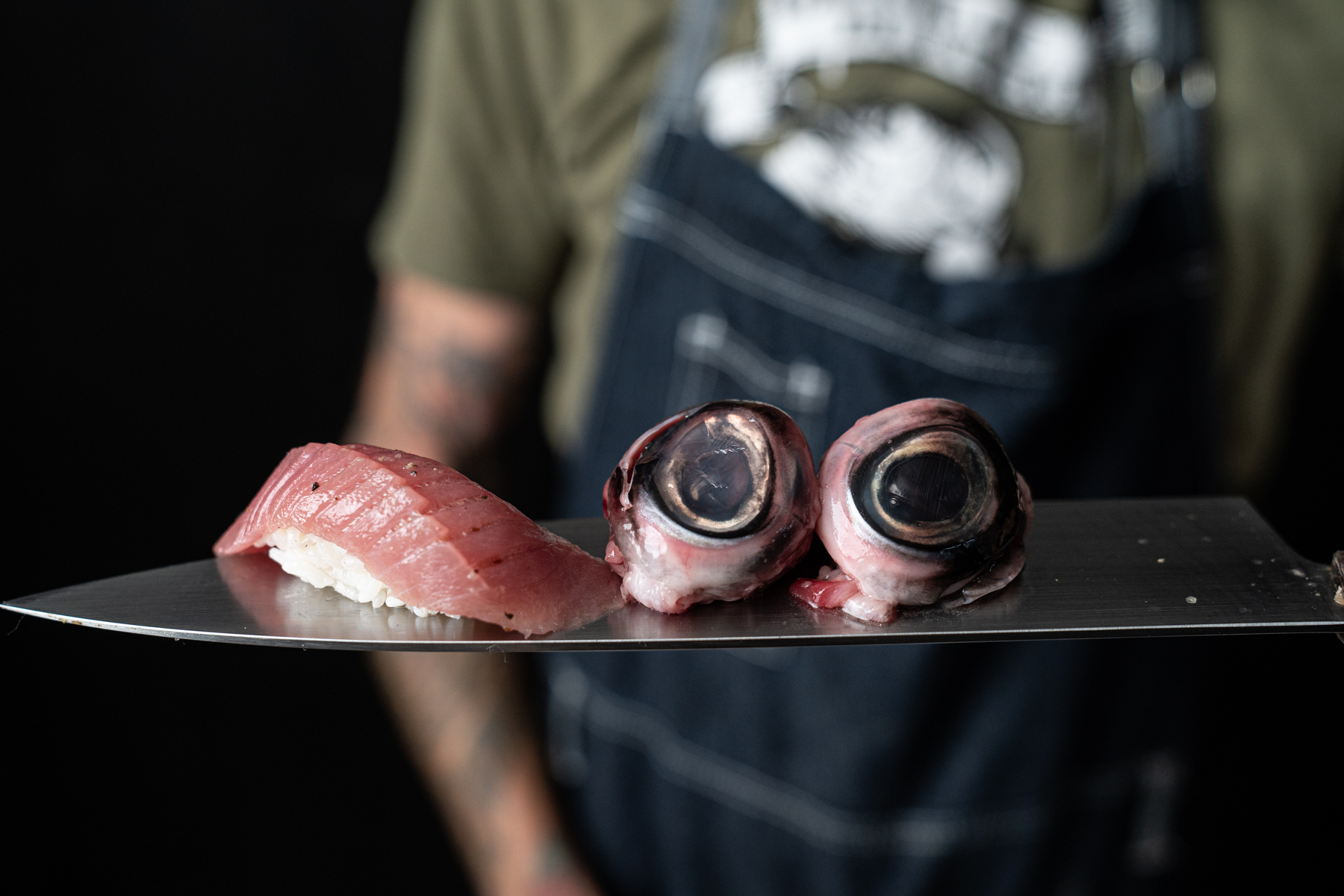 |
| Photo: Chef Epic |
When in a sushi restaurant in Japan, you’re likely to see cuts of tuna belly in maki rolls or on their own as sashimi. However, walk through a fish market or grocery store, and you’ll see a very different part of the tuna gazing at you: its eyeballs.
Japanese chefs cook the fleshy, tennis ball–sized eyeballs as appetizers or bar snacks. The eye consists of a hard exterior, known as the sclera, which holds the lens, the iris, and gelatinous fluid. When cooked, the sclera is usually too chewy to eat, but the inner contents of the eye become soft, and can be easily sucked out like bone marrow. Chefs often lightly braise eyeballs in a mixture of soy sauce and mirin or sautée them with sesame oil and ginger. The eyeballs themselves are rather bland—most tasters liken them to squid, mussels, or hard-boiled eggs.
Today, tuna eyeballs can usually be found in Japan’s izakayas, casual, after-work pubs that dispense hors d’oeuvres and drinks. The cooked eyeballs are served one or two at a time, alongside other dishes. If you’re lucky, you may even be able to pair them with a shot of “tuna’s tears,” a rare drink made with soju and raw tuna lens.
You are more likely to find tuna eyeballs at restaurants or izakayas that specialize in tuna dishes. Although some sources claim that tuna eyeballs can be eaten raw, it’s best to stick to cooked versions, since the raw eyeballs can quickly accumulate bacteria.
3. Balut, the Philippines
 |
| Photo: Sugarcookie |
Balut or balot (“bah-loot,” both singular and plural) is a famous Filipino food that tends to either fascinate or revolt foreigners. It is a 16-to-21-day-old fertilized duck egg that contains not only a yolk but also a semi-developed duck embryo. Often hailed as one of the Philippines’ most iconic and exotic delicacies, it is cracked open and eaten with a dash of salt and not much else. Below we’ll tell you more about eating balut—if you like hard-boiled eggs, you’re halfway there!—but first, some backstory.
The truth is, balut is not unique to the Philippines—it also exists in nearby Vietnam, Laos, and Cambodia—and it’s said to have been brought to these shores (once again) by the seafaring, island-hopping Chinese. The name is derived from the idea that when you crack open the shell of a cooked balut, the duck embryo should be “balut sa puti” (literally, wrapped in white). To make it, the duck eggs are brought to the magbabalot (“mag-ba-ba-loht,” balut maker) on the day the eggs are laid. The fertilized duck eggs (determined through candling) are incubated in baskets surrounded by warmed rice husks until they’re ready to be boiled and sold.
Balut from Pateros, a municipality on the eastern end of Metro Manila, is believed to be the best in the country, but you don’t have to travel far to find a good specimen in this city. Vendors used to shout “Baluuuuuuuut!” as they walked the streets or pedaled around, drawing out the second syllable for as long as they could (much like those taho vendors), their warm balut in cloth-covered baskets. These days, the yodeling is more commonly heard on residential streets, and balut vendors can be a bit less itinerant, parking themselves on various street corners, or even replacing the traditional baskets with decidedly less rustic Styrofoam boxes, “balut” written on the side.
Despite the changes, balut remains the favorite snack of overtime workers and night owls, as it’s believed to be high in protein and a healthy midnight snack—excellent recovery food on your way home from an alcoholic binge as well as, some will swear, a good aphrodisiac.
4. Fried tarantulas, Cambodia
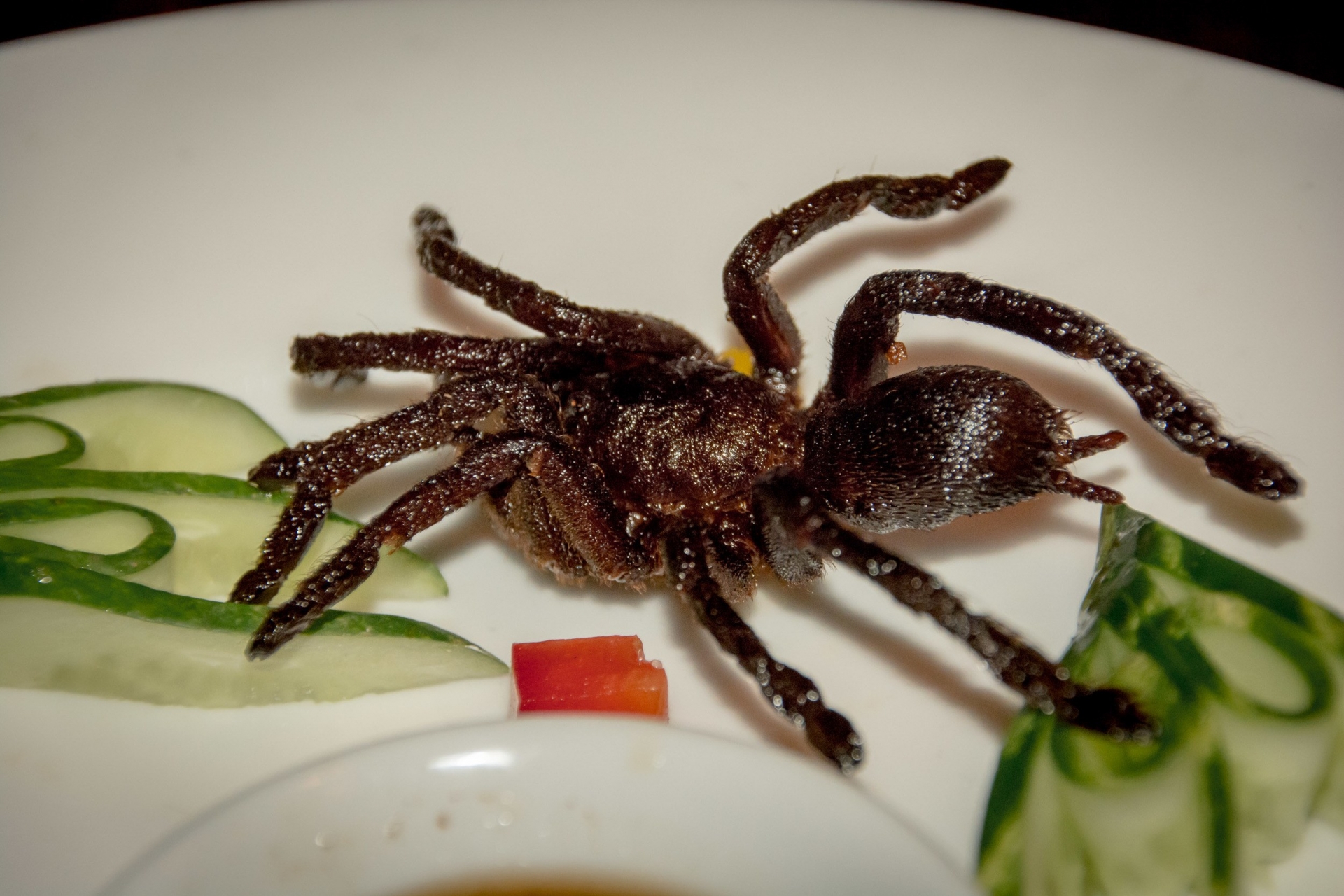 |
| Photo: Food Fun Travel |
The city of Skuon in Cambodia is so infested with spiders that the nearly-starved locals have adapted and started consuming them in the 1970s, and the practice has continued ever since. It is no wonder that the city is known as Spider Town or Spiderville.
The spiders (usually tarantulas) are breaded and deep-fried in hot oil, then served with some fresh local herbs on a bed of rice or noodles. The flavor of these critters has been described as a cross between cod and chicken – at least the hairy legs are supposed to taste so, because consumers are warned not to bite into the abdomen, which contains spiders’ internal organs and bodily fluids.
5. White ant eggs soup, Laos
 |
| Photo: The Economist |
Take a break from your standard chicken or tomato soup and consider having a bowl of white ant eggs soup. This unusual soup tastes a little like shrimp and is made from a mixture of ant eggs and partial embryos from a white ant, in addition to a few baby ants to add a hint of sourness. You may think this unusual dish is made from a strange concoction, but this delicacy is supposedly quite tasty.
Ant egg soup is a Laotian dish made of ant eggs, mixed with snakehead fish, garlic, galangal, lemongrass. tamarind bean, lime juice, basil leaves, tomatoes, and fish stock.
6. Jellied moose nose, Canada
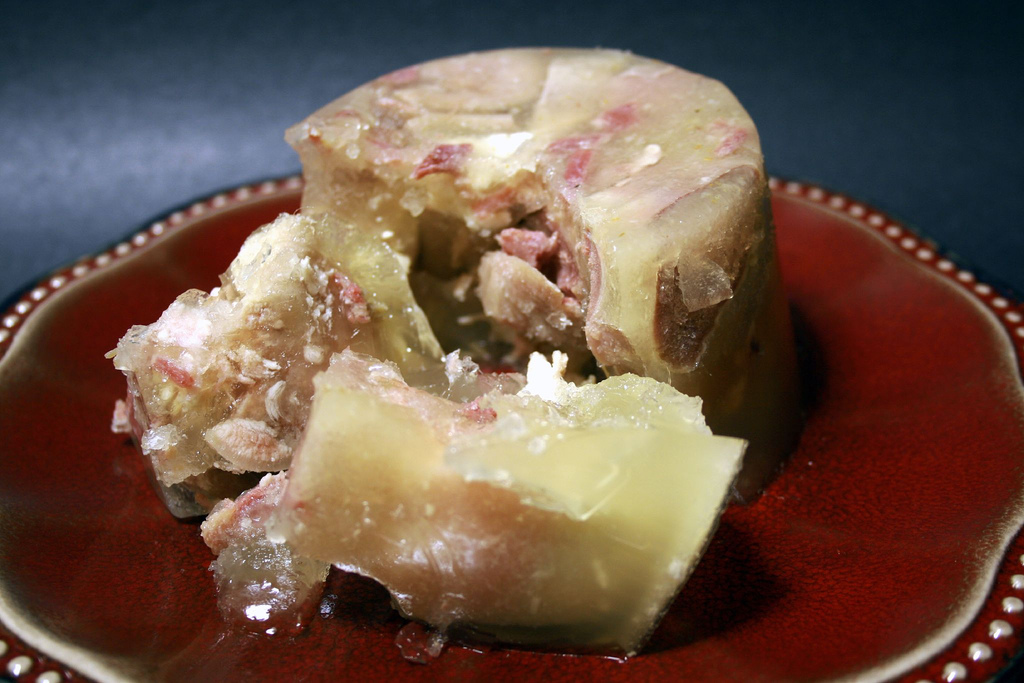 |
| Photo: The VALiens |
In the past, indigenous hunters in the greater Northwest could rely on one whole moose to feed a family for weeks. Every part of the animal was eaten or preserved, including the nose. The moose’s long, bulbous snout is still considered a delicacy among indigenous communities. Jellied moose nose is similar to European head cheese, trapping cuts of moose nose within a gelatinized broth. The dish was even mentioned in the Northern Cookbook, a 1967 publication by the Canadian government that offered recipes and cooking advice for “wilderness wives” living in the backwoods of the far north.
A moose’s nose contains both white meat (from the bulb of the nose) and dark meat (from around the bones). The fur must be removed prior to cooking, either by being singed off over an open fire, peeled off after the nose has been boiled, or simply skinning the nose. Chefs then slice the nose and simmer it with onions, garlic, and an array of other spices, which may include cinnamon, cloves, allspice, or mustard seeds. Meat from other parts of the moose’s head, such as the ears and lips, may be added to the mix. Once the concoction has cooled down, the cook lays the pieces of meat in a loaf pan, douses them with broth, and places the mixture in the refrigerator so the broth can solidify. The resulting jelly is served like a loaf of bread and eaten in slices.
Moose meat tends to be lean and gamey; jellied moose nose, however, is more complex. Chef Andrew Zimmern described the dish as exploding “with little tastes,” likening the flavor to corned beef. When different cuts from the moose head are mixed together, the jelly sports a variety of textures, from the chewiness of nose cartilage to the tenderness of cheek meat.
7. Boshintang, Korea
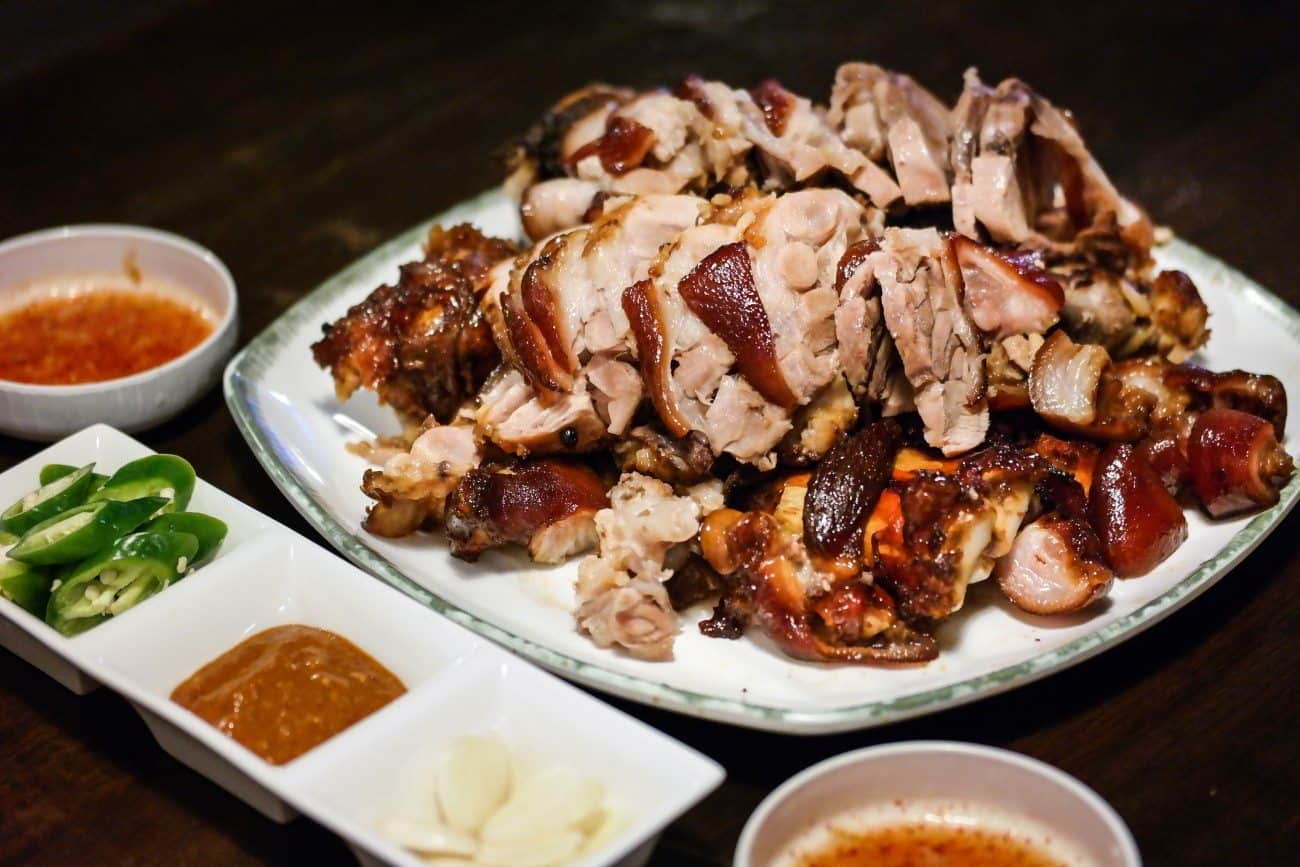 |
| Photo: Miss Tam Chiak |
Bosintang is a soup that's prepared by boiling vegetables, namely green onions, perilla leaves, and dandelions with dog meat. The soup is seasoned with doenjang (a type of thick Korean bean paste), gochujang (Korean condiment), and perilla seed powder.
Right before eating, bosingtang is additionally flavored with Agastache rugosa (Korean mint). Said to taste a bit like lamb, dog meat is the fourth most commonly consumed meat in South Korea, and despite many misconceptions, eating it is not illegal in the country.
However, it must be said that the consumption of dog meat has declined significantly among younger and urban populations, and continues to decline further, with most people nowadays in Korea saying they have never tried it and/or never would. Also, there's been ongoing pressure from the animal rights groups to ban the farming and consumption of dog meat in South Korea, with some small legal victories they've won thus far in an effort to achieve that goal.
8. Huitlacoche, Mexico
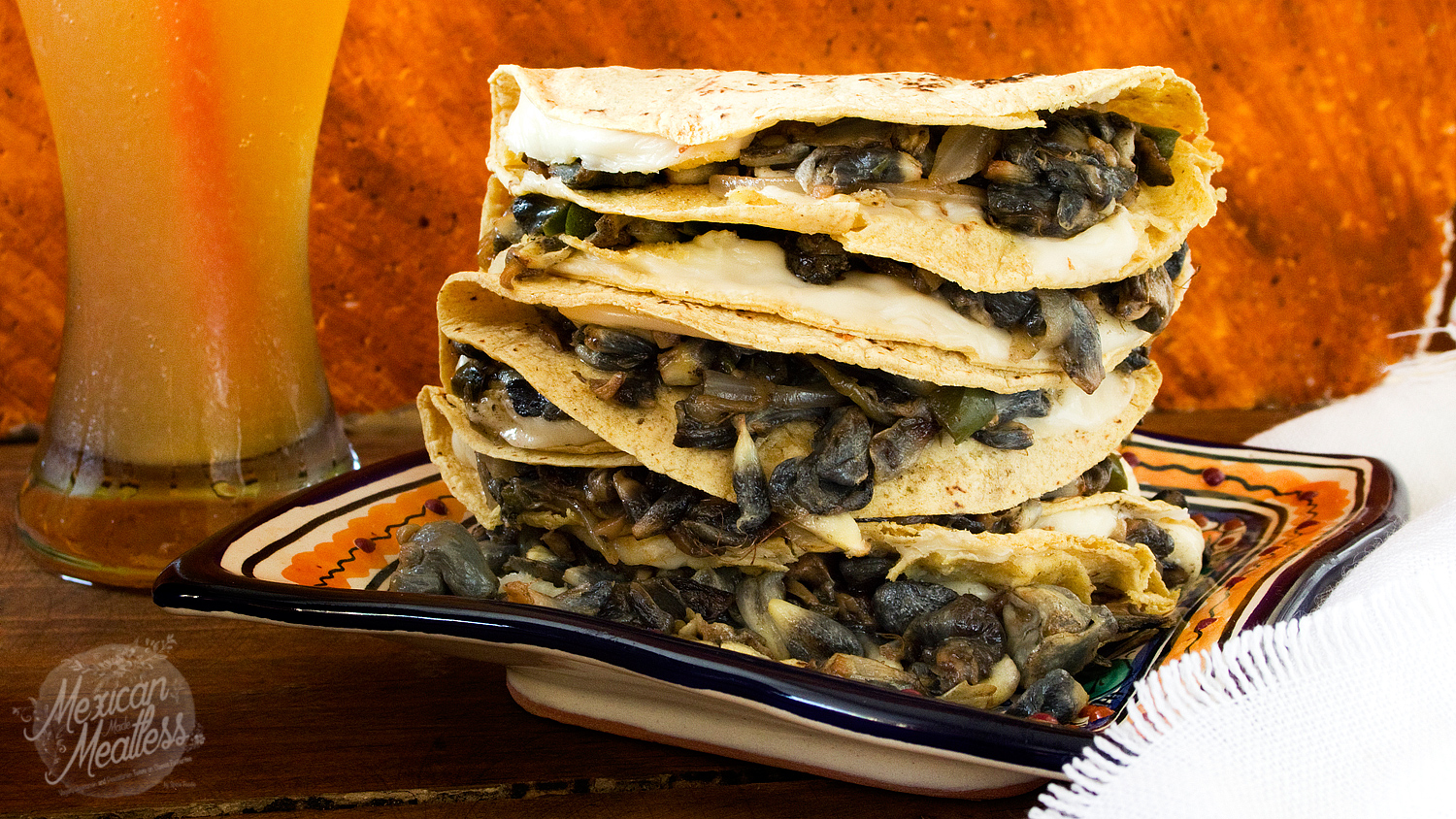 |
| Photo: Mexican Made Meatless |
Pronounced whee-tla-KO-cheh, huitlacoche is also known as corn mushroom, corn smut or Mexican truffle. It is a fungus, which randomly grows on organic corn (not sprayed with any fungicide). It is rare, as it develops on the corn ears as they ripen after the rainy season or an errant rainstorm. Huitlacoche will consume the corn kernels and push itself out through the corn shucks, easily visible in a cornfield.
In Mexico, you will find baskets of fresh huitlacoche in the farmers' markets. The food stands regularly serve up warm and delicious thick corn patties filled with huitlacoche, corn kernels and onions – to the delight of the local patrons. You can buy this delicacy fresh in Mexico, but it is usually only found in cans in U.S stores.
The savory huitlacoche is used in tamales, stews, soups, corn patties, quesadillas and even desserts. It has become a sought-after ingredient, served in some of the finest menus across the country – including the James Beard House in New York City. For a quick and delicious homemade filling, add diced huitlacoche to sautéed onions or garlic, cook for a few minutes until it blackens, then add tomatoes and chiles and slow-cook another 20 minutes.
9. Stargazey Pie, England
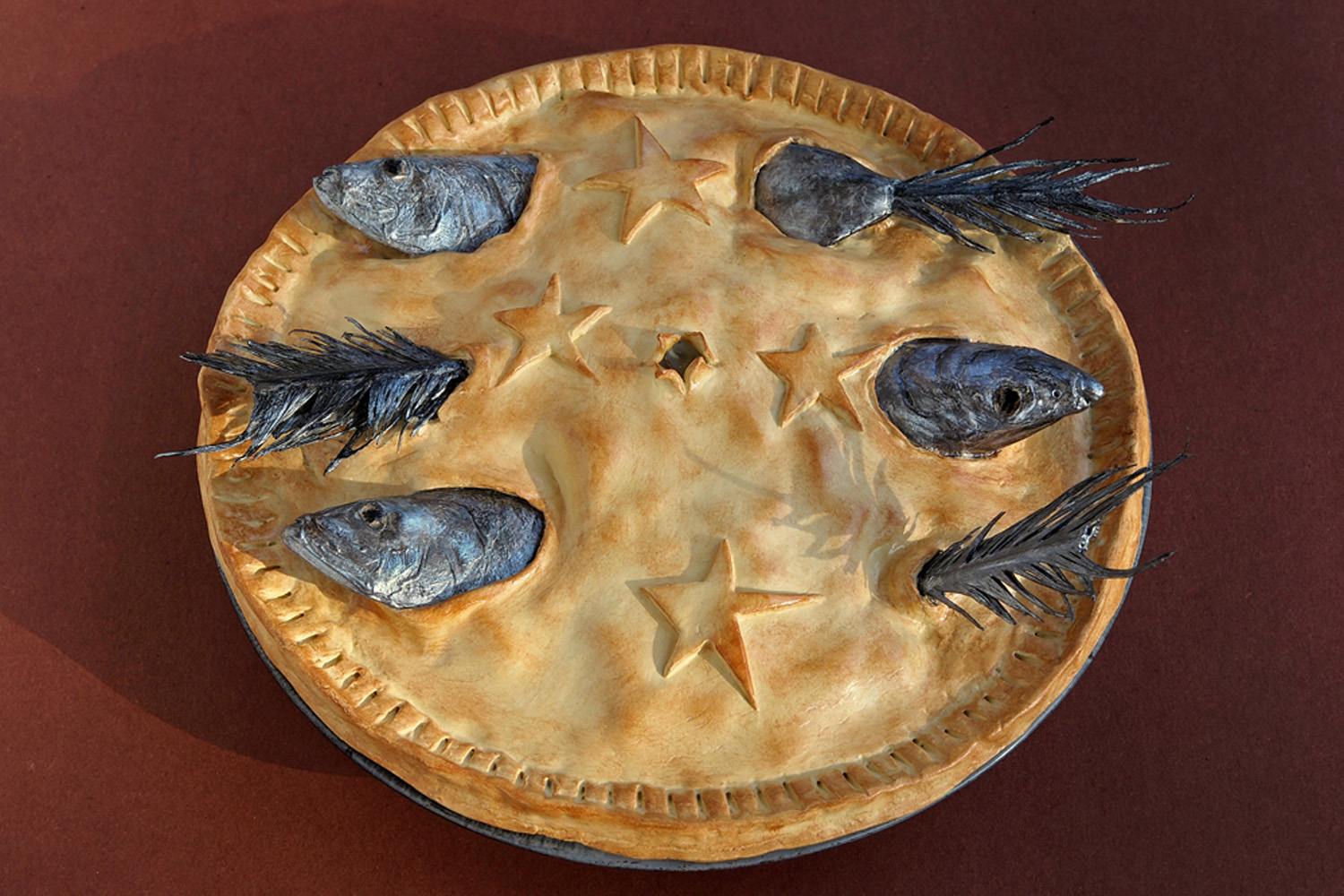 |
| Photo: NPR |
Stargazy Pie is an odd-looking invention: The heads and tails of pilchards poke out of a shortcrust lid. Their bodies, meanwhile, are tucked under the pastry; a white sauce envelopes them. Salty and formidably traditional, it's seasoned with coarse pepper and parsley.
Inside the steaming pie, a grating of boiled egg adds a touch of nourishment; an earthy stock supplies a base. It's hearty cooking—what you might imagine tucking into on a cold winter's night in a quaint Cornish village. It all smells of a buttery sea—and tastes much the same.
But Stargazy Pie is more than just an intriguing food item. It's said to be born of famine, in Cornwall's tiny port of Mousehole. The story goes that many years ago—it's not known exactly when—winter storms were thrashing the village with all their roaring anger, as they do. And this was when such weather cut off the region from the rest of England. People were going hungry.
So a local man called Tom Bowcock bravely sailed out to sea and returned with fish aplenty. Into a pie his catch went, and every year since on December 23, a festival—Tom Bowcock's Eve—is celebrated by all. I can say from experience that it's a lively affair. Cornish locals like to dance, sing, and make good pastry.
You might've read something similar in the famous children's book The Mousehole Cat, which was inspired by Mr. Bowcock's endeavour. Such is the notoriety of the fisherman that his life is well-chartered in literature—allegedly, he was first proclaimed a folk hero in the magazine Old Cornwall in the 1920s.
It's on Tom Bowcock's Eve—and only then—when the Stargazy Pie is cooked and eaten. It's Mousehole's Christmas and its festive grotto is The Ship Inn, a centuries-old drinking hole perched on the edge of the harbour's rear wall.
Every year, this pub dishes out free Stargazy Pie to all: from fishermen to school kids, to hordes of tourists, great baking trays of steaming pies emerge from the kitchen. There's plenty of Cornish ale and singing to accompany them.
10. Casu marzu, Italy
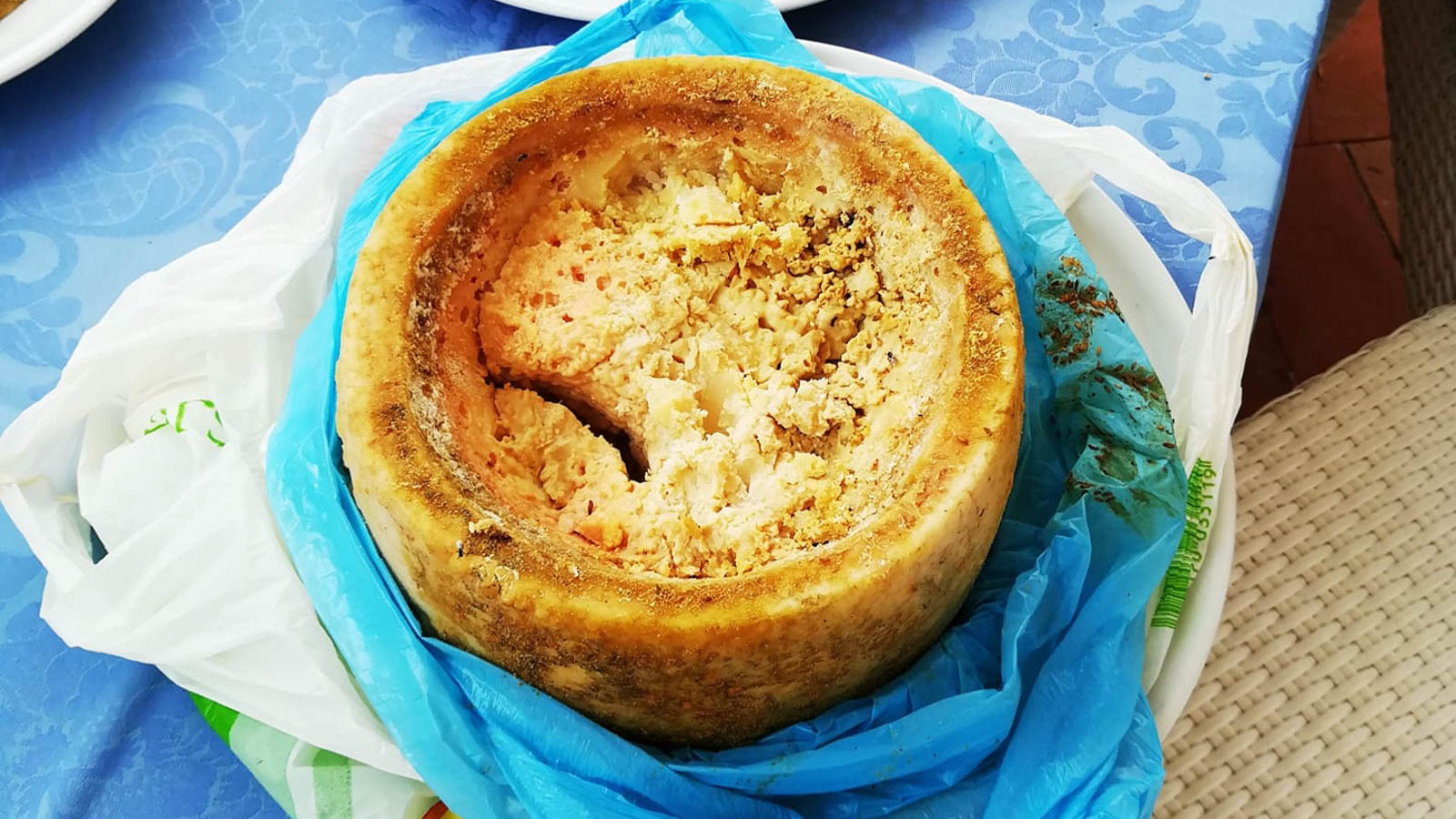 |
| Photo: CNN |
The Italian island of Sardinia sits in the middle of the Tyrrhenian Sea, gazing at Italy from a distance. Surrounded by a 1,849-kilometer coastline of white sandy beaches and emerald waters, the island's inland landscape rapidly rises to form hills and impervious mountains.
And it is within these edgy curves that shepherds produce casu marzu, a maggot-infested cheese that, in 2009, the Guinness World Record proclaimed the world's most dangerous cheese.
Cheese skipper flies, Piophila casei, lay their eggs in cracks that form in cheese, usually fiore sardo, the island's salty pecorino.
Maggots hatch, making their way through the paste, digesting proteins in the process, and transforming the product into a soft creamy cheese.
Then the cheesemonger cracks open the top -- which is almost untouched by maggots -- to scoop out a spoonful of the creamy delicacy.
It's not a moment for the faint-hearted. At this point, the grubs inside begin to writhe frantically.
Some locals spin the cheese through a centrifuge to merge the maggots with the cheese. Others like it au naturel. They open their mouths and eat everything.
****READ MORE: Top 10 Traditional Dishes You Must Try in Brazil
11. Muktuk, Greenland
 |
| Photo: Slate |
Muktuk is one such dish that uses cuts of meat that are unconventional to the modern palate, but help utilize the whole animal. A deeply traditional Inuit food, muktuk consists of the skin and blubber of a whale, usually a bowhead, beluga, or narwhal, depending on the indigenous community. It’s best served raw in tiny cubes, but it can also be deep-fried, pickled, or stewed.
Depending on the type of whale, muktuk may look like a black cap of skin with soft, pinkish-white blubber, or striated layers of gray, white, and pink—like pork belly, but better. The skin is frustratingly elastic, and is often scored to make chewing somewhat easier. The blubber, however, melts gently as you chew, whispering of the ocean from whence it came, but never overly fishy or briny.
When it comes to muktuk, keeping Sedna happy is both easy and delicious.
Muktuk is a rich source of vitamin C, critical in the North where diseases such as scurvy remain a threat.
12. Hakarl, Iceland
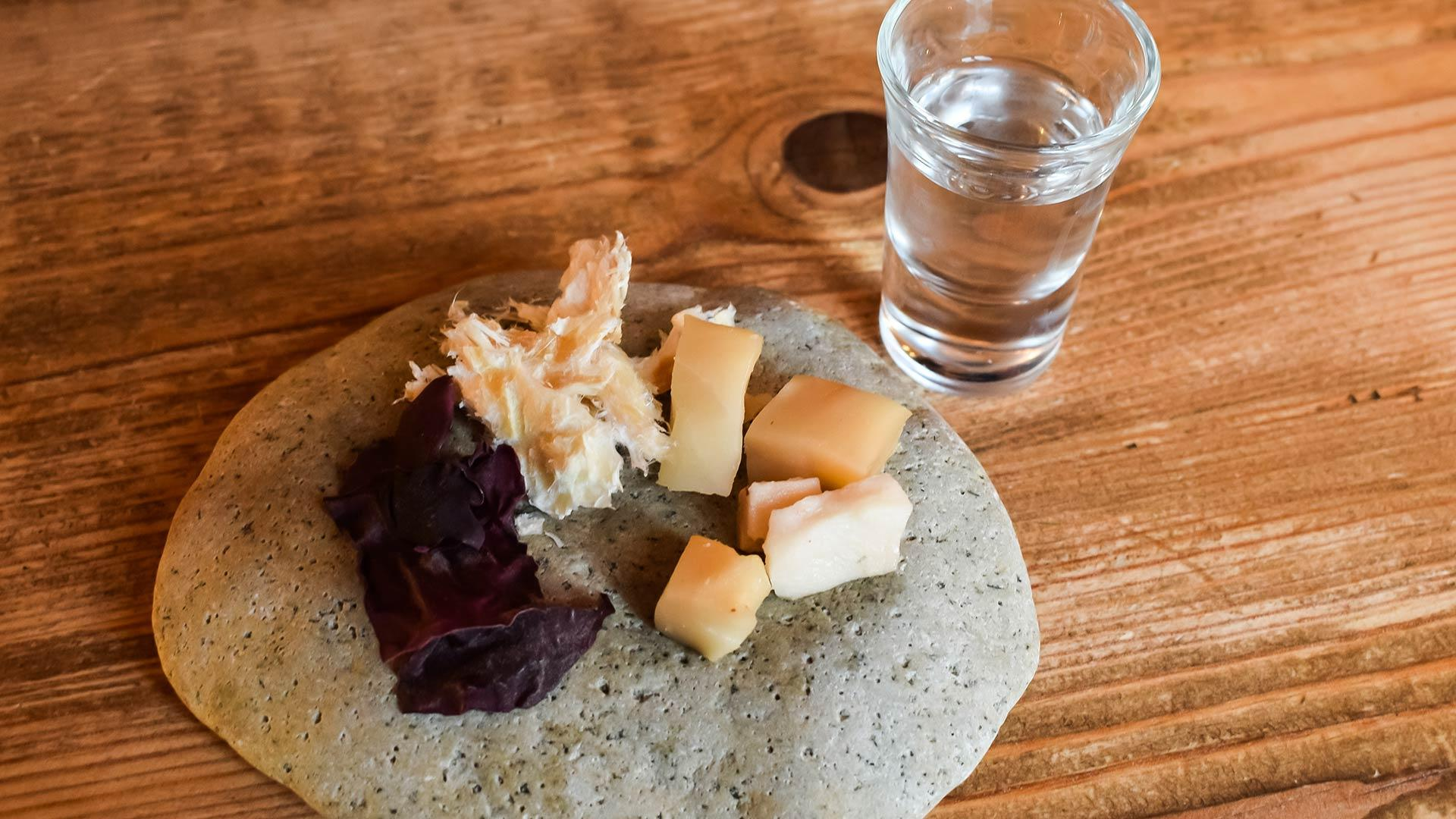 |
| Photo: Getty Images |
It is never easy to talk about Hákarl because the description of this typical Icelandic dish tends to confuse people. In brief, you have to taste it for yourself to realize how it is perceived by the palate. Are you wondering why we are introducing it in such a diplomatic and circumspective manner? This is because the idea of eating shark meat isn’t for everyone. Then, when it comes to eating shark meat that stinks of urine, its level of appeal falls drastically. But… and there is always a but: if you manage to get over the initial impact, possibly by holding your nose between finger and thumb, you may discover a particular flavor which some people even find enticing.
The history of Hákarl is somewhat nebulous, even though it is generally associated with the Viking age. Until then, sharks were contemplated as enemies, or, at the best, as a source of fat for using as a lubricant. Indeed, the meat of the Greenland shark is poisonous and can intoxicate whoever eats it for several days. This is because sharks have no kidneys and therefore expel urine from their entire body. In a few words, its flesh is full of it, with a concentration of urea and trimethylamine oxide that is certainly not very inviting.
When ready, Hákarl is served without its characteristic outer crust, diced into small pieces. They are eaten just as they are by habitual consumers or served in a glass-topped-up with Brennivín, the Icelandic aquavit. In this way, the smell is mitigated and the approach to this food is a bit more gentle.
You will probably have gathered that eating Hákarl is more of a challenge than a pleasure and, in actual fact, it is usually presented to the unwitting tourist in this light. However, there are some who, after tasting it, and this includes me, liken it to cheese with an intense smell and taste, such as gorgonzola.
De gustibus non est disputandum, as the Latin saying goes. When you taste this delicacy, try not to breathe in through the nose and let your taste buds do all the work, without being overpowered by the strong and nauseating smell.
13. Century egg, China
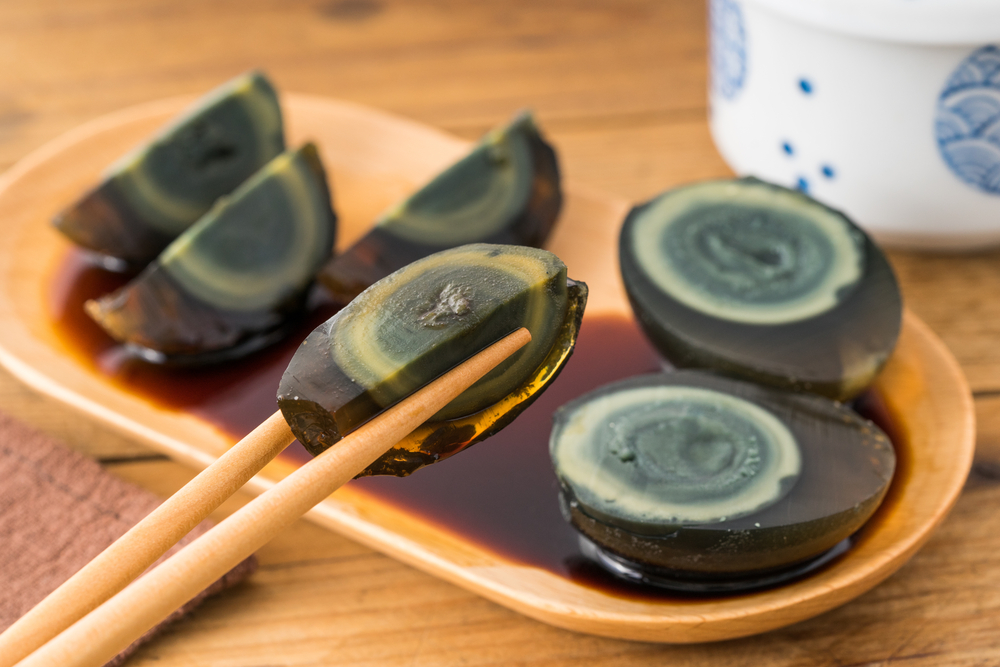 |
| Photo: Shutterstock |
Century eggs are one of the traditional delicacies originating from China. This research investigated the difference between traditional and industrial methods of making century eggs, through various factors such as the number of steps required and time required for century eggs to complete their formation. Secondary to this comparison, the chemical process and scientific theory behind the formation of these eggs were explored. The traditional method involved wrapping a batch of eggs in a chemical clay and leaving them for 10 days. The industrial method, however, involved soaking the eggs in a chemical solution for a while. Both methods observed century egg formation in which the albumen proteins denature under an alkaline condition. However, the stated 10 day period of the traditional method was not enough to completely preserve the eggs. Future experiments could include chemically dissolving the eggshells in advance to reduce the diffusion barrier and distance for the alkaline conditions to reach the albumin of the egg. In turn, this would reduce the time required for century eggs to form, meaning that production costs could be lowered.
Century egg has a wide range of benefits, particularly over traditional eggs including:
• Great source of Iron
• High protein nutrition
• Great source of Vitamin D
• Excellent source of Selenium
• Lowers blood pressure
• Increases liver function
• Improves vision
Century eggs can either be served as a main dish or as an appetizer. For instance, a well-known Cantonese street food is century egg sandwiched between slices of pickled ginger root.
They are also commonly consumed with chilled tofu in Shanghai and Taiwan. Century eggs can be sliced and added to an omelette made with fresh eggs, this dish is called ‘old-and-fresh’ eggs.
Cutting century eggs into chunks and adding them to other dishes such as congee, soup, tofu salad, or even pastries is quite common. While century eggs are treated as a delicacy in the west, they’re actually quite common and easily available in East Asia.
14. Salo, Ukraine
 |
| Photo: Shutterstock |
Salo is a popular Ukrainian food which is served raw and cooked and eaten not only salted but also sweetened (and it’s not a joke but a formed gastronomic peculiarity). In Ukraine pig fat is served both as a standalone dish and as diverse additives with dozens of dishes.
Salo can be served raw salted or smoked. It can be cooked as cracklings that are eaten with bread, potato or added as pie fillings. Such dishes as meat with potato stew, rissoles larded with garlic, buzhenyna (baked ham) stewed with cabbage, kruchenyky (pork or beef rolls with various stuffings) can’t go without such vital product of the Ukrainian cuisine as salo. Salo is also used to lard the meat and make it more juicy.
The uniqueness of pork lard lies in the fact that it can’t be oversalted. No matter how much salt you’ll put on a piece of salo, it’ll take as much as it needs, no more and no less.
In the Ukrainian folklore salo is one of the main characters of jokes and anecdotes. Festivals and fairs specialized on pork fat are held yearly. Even a magazine with the title «SALO» exists. Taking into account all the above mentioned, there is no wonder that this product has truly become the iconic symbol in Ukraine.
*****READ MORE: Top 40 Most Delicious Foods in The World
15.
Airag, Mongolia
 |
| Photo: On The Gas |
Airag, or Ayrag, is the traditional Mongolian fermented mare's milk alcoholic drink. As the traditional national beverage of Mongolia, you cannot miss it while traveling to the country. For many people outside of Mongolia, Airag is better known as kumis, which is the name given to all fermented mare's milk beverages throughout Central Asia.
Mongolians make this delicious drink by filtering the mare's milk through a cloth and pouring it into an open leather sack called Khukhuur. This is the usual, traditional method, but sometimes, Mongolians use a vat from larch wood called Gan, or they simply use plastic.
The next step is to stir the milk with Buluur – a wooden masher. The stirring needs to be repeated many times throughout the day for one or two days. Traditionally, the Mongols place the Khukhuur next to the entrance of the ger, so anyone entering or leaving the ger can give the drink a stir.
Airag usually has up to only 2% alcohol and has a slightly sour, yet delicious taste that's agreeable to most people. The exact taste varies a bit, depending on the method of production.
It's one of the few alcoholic beverages in the world that's also a potent source of vitamins and minerals.
What's interesting about Airag is the fact that a person who is lactose intolerant can drink it. That's because the fermentation process converts all the lactose into lactic acid, ethanol, and some carbon dioxide. Many Mongolians are also lactose-intolerant, like many people of East Asia, which is why they can drink Airag.
 TOP 10 Best Traditional Foods in China TOP 10 Best Traditional Foods in China China is famous all over the world for not only its unique history, but also the tastes of thousands of special food. Today Knowinsiders would ... |
 Top 7 Most Famous Foods in France Top 7 Most Famous Foods in France France has and always will be iconic for its incredible food. No matter where you go when you move to France you will find unforgettable ... |
 Top 10 Most Delicious Foods in Vietnam Top 10 Most Delicious Foods in Vietnam Vietnamese food is known to be both healthy and robust in flavor, thanks to its generous combination of fresh herbs and greens, paired with ... |
 Best Traditional USA Dishes: Top 10 Must-try American Foods Best Traditional USA Dishes: Top 10 Must-try American Foods Regarding American cuisine, classics and junk food like burgers, chips, hot dogs, pancakes are the most popular and well-known, contributing to the “typical American lifestyle”. ... |


























